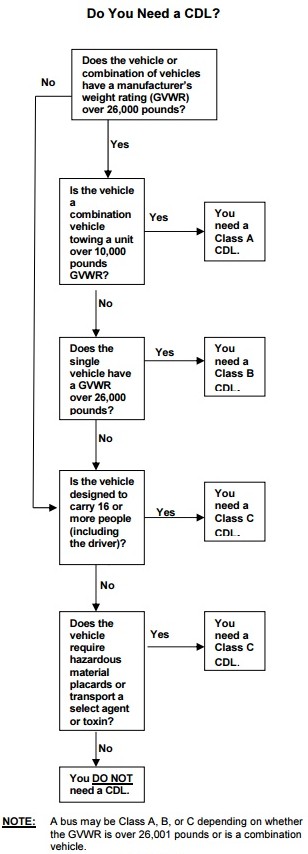This post goes over everything there is to know about the different CDL endorsements and how to earn them.
The Transportation Industry Is Booming, And With This Boom There Has Been An Increase In Demand For Great Qualified Drivers.
And it makes sense:
The trucking and commercial transportation industry accounts for about 71% of the freight tonnage that moves throughout the United States. This is made possible by over 3.6 million heavy duty trucks and over 3.5 million truck drivers.
There’s only one problem:
There aren’t enough qualified drivers to go around.
In fact, The American Trucking Association claims that this shortage sits at around 51,000 drivers, and predicts that this shortage will increase to 170,000 drivers by 2026. If that doesn’t seem like much relative to that big 3.5 million total, think about it this way:
That’s over 1,000 drivers short in every US state, causing trucking and transportation companies to scramble for available options, and causing shippers and producers to raise their prices.
So what does all of this mean?
In short, there’s never been a better time to earn your Commercial Driver’s License (CDL) and become driver.
Tack on the possibility of earning endorsements that raise your qualifications and the compensation becomes even more competitive as an extremely viable career path.
Today we’re going to learn everything there is to know about the different CDL endorsements and how to earn them.
Before you know it, you’ll be well on your way to becoming a sought after commercial driver!
What Is A CDL License?
A CDL essentially serves as proof that you are a licensed and skilled commercial driver.
Driving a large truck or even a refrigerated van isn’t the same as driving any old vehicle. It takes a specialized skill set and knowledge of how to operate certain aspects of the vehicle that are not present in regular cars.
Before the CDL program was implemented, this wasn’t the case, and anyone who was licensed to drive a car could also drive a commercial vehicle.
Can you imagine trying to safely drive an 18-wheeler with zero skills or proper training? Yikes!
This all changed with the Commercial Motor Vehicle Safety Act of 1986, which was created with the goal of improving highway safety by making sure that commercial drivers were qualified. It also removed a great deal of unqualified drivers from circulation.
Why do I need a CDL License?
In short, you need a CDL to drive commercial vehicles because it is required by law.
Also, in order to properly perform the functions of a commercial driving job, you will need the skills and training provided during the CDL training process.
In order to get a Commercial Driver’s License, drivers need to pass knowledge and skill tests while adhering to standards issued by the Federal Highway Administration (FHA).
Types of CDL Licenses
There are three different types of CDL licenses: Class A, Class B and Class C.
Let’s go over the three classes below:
Class A CDL: Combination Vehicle
A Class A CDL allows drivers to operate any combination of vehicles that have a Gross Combination Weight Rating (GCWR) of 26,001 pounds or more. This includes a towed unit or more with a gross vehicle weight of over 10,000 pounds.
An example of a Class A driver would be an interstate tractor-trailer driver.
Class B CDL: Heavy Straight Vehicle
A Class B CDL allows drivers to operate a single vehicle that has a GVWR of 26,001 pounds or more. The vehicle can be towing a vehicle that weighs under 10,000 pounds.
Class C CDL: Small Vehicle
A Class C CDL allows drivers to operate a single or a combination of vehicles that is designed to transport 16 or more passengers, including the driver, or is used for the transportation of hazardous materials.
Here’s a helpful flow chart from Trucker Country that can help you decide whether you need a CDL:

What are CDL Endorsements?
Having a Commercial Driver’s License allows you to drive commercial vehicles, but if you have a specific specialization in mind, you may need to earn an endorsement.
CDL endorsements are essentially permissions that show you have gone through extra training and can operate a specific type of commercial vehicle or transport a specific type of freight.
When you are in the process of earning your CDL, you can inform the DMV of the types of endorsements you would like to earn. Keep in mind that endorsements, and the requirements for earning them, can vary from state to state.
Earning an endorsement is often as simple as passing an additional test. Some endorsements, such as the Hazardous Materials Endorsement are a bit more complicated to earn. Applicants must go through a Security Threat Assessment, which includes fingerprinting and a background test, in addition to passing a knowledge test.
Types of CDL Endorsements
There are 6 different types of CDL endorsements. Let’s go over each of them:
CDL Endorsement Code H: Transporting Hazardous Material(S)
Earning the hazardous materials endorsement (HAZMAT) can be a great opportunity for commercial drivers. Many companies rely on the transportation of hazardous materials but it can be difficult to find enough drivers with the certification.
As specified above, the HAZMAT certification is a bit more complex than the others, as it requires fingerprints, a background check and educational material to be completed and passed before it can be awarded.
CDL Endorsement Code N: Operating A Tank
A regular Commercial Driver’s License only allows drivers to transport dry goods. If drivers want to be able to transport liquids, they need to receive their tanker vehicle endorsement. Pursuing this endorsement involves learning about how to ensure the tanker vehicle is safe for transport, loaded correctly and that the driver is ready to address any leads that could occur.
CDL Endorsement Code P: Operating A Passenger Transport Vehicle
A standard CDL does not allow drivers to operate passenger vehicles. The passenger endorsement allows drivers to legally transport a larger quantity of passengers on vehicles such as city buses and tour buses.
CDL Endorsement Code X: Transporting Hazardous Materials In A Tank
This is essentially a combination of a HAZMAT endorsement and an endorsement for operating a tanker vehicle. It requires additional training but will open a driver up to a great deal of new opportunities.
CDL Endorsement Code T: Towing A Double Or Triple Trailer
A standard CDL only allows drivers to operate a single trailer vehicle. If drivers pass the test to receive endorsement code T, they will be able to tow two or 3 trailers, which could open them up to a greater number of trucking job opportunities.
CDL Endorsement Code S: Driving A School Bus
Similar to endorsement code P, which allows drivers to transport a larger quantity of passengers, code S requires that students pass a knowledge test and a skills test. In addition, it requires that driversstudents pass a background check.
Why do I need CDL Endorsements and What are the Benefits?
CDL endorsements are not an absolute necessity for most drivers. In fact, the driver shortage right now is so significant that most transportation companies just need reliable, qualified commercial drivers.
However, CDL endorsements do allow commercial drivers to specialize and make their services even more desirable to transportation companies. In today’s competitive landscape, it can also lead to higher wages, along with more favorable hours and routes.
If you are thinking about pursuing any specific CDL endorsements, put some thought into what type of driver you want to be, the types of goods you want to transport, and the distances you would prefer to cover.
Contract With Winnesota
Whether you already hold a CDL or are considering becoming a commercial driver, Winnesota can provide you with career opportunities that will fit your lifestyle.
